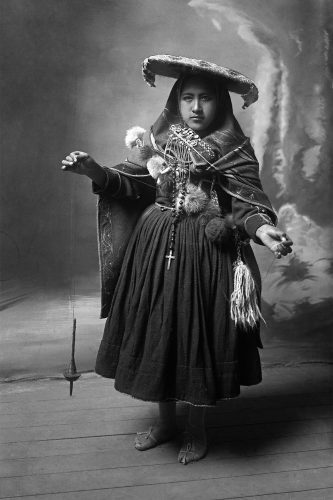
If you’re like most people, you probably haven’t given much thought to, say, Peruvian photography of the early 20th century. Don’t feel bad. You’re not alone.
I’m a photo junkie and, until a few weeks ago, the subject of Peruvian photography was completely off my radar, too.
Yes, until just a few weeks back, 1920s Cusco was a blank slate. But the wonderful exhibit QOSQO, Entre El Pasado y El Presente: Photography In Cusco 1895-1945, now showing at the Jordan Schnitzer Museum of Art, changed all that in one fell swoop.
After a brief initial visit, my mind was swimming in images of Cusco, a large and ancient city in the Peruvian Andes.
What a world it was! There’s a wake on display, along with an Archbishop’s peepshow, prostitutes, a Bohemian picnic, a payday and mugshots. Cusco was a land of huge stone structures and plazas, strange costumes and customs, all garnished with a seemingly infinite variety of hats.
This was planet Earth, yes — but a version so dislocated in time and geography as to appear alien to my contemporary mind.
The Cusco region was not only buzzing with life a century ago, but crawling with photographers. They documented the scene on large glass-plate negatives.
These images might have been forgotten if not for the efforts of co-curator Peter Yenne.
Intrigued by the brilliant photos of Martin Chambi, who’d come to belated prominence in the late 1970s, Yenne went to Peru to explore the archives. He teamed with co-curator Adelma Benavente Garcia to produce an early iteration of the show called Visions Of Modernity, featuring Chambi along with 10 other early Peruvian photographers.
The next version, Portrait Of The Andes, incorporated the improved potential of digital reproduction to create the inkjet images now showing at JSMA.
From the very get-go, QOSQO’s curation (the city’s name means “Navel of the World” in Quechua) assumes a skeptical stance, beginning with the opening description of a Cusco where “Edwardian dandies reluctantly rubbed shoulders with an indigenous population whose customs and dress predated the Conquest.” All residents were invested in the city’s renaissance, but the melting pot was not a smooth mix.
Instead, the city was a living experiment in colonialism, as recently settled Europeans attempted to impose class roles while the burgeoning Indigenismo movement advocated Inca cultural reawakening.
The tension is evident throughout the JSMA show in captions describing underlying societal divisions. With their aid, many of the photographs are revealed as subtly classist artifacts. Something as innocent as a stray hand on a shoulder takes on an ulterior meaning, a taboo power dynamic.
Its photographic erasure — the hand is blotted out — is even more disturbing, an ancient precursor to today’s “fake news.”
Similar impulses show up in a photograph of a lower-class wet nurse holding a baby, her figure deemed unimportant and hidden from view under a blanket. Cezar Meza’s studio portrait of two gentlemen seems innocent enough, until the caption’s revelation of their power dynamic — landowner and assistant — casts their expressions in a new light.
The show’s unspoken subtext is that photography itself was a colonial import. It may be hard to believe in an era when everyone has a camera — visitors can test this out for themselves in the show’s portrait backdrop — but for its first several decades, photography remained the domain of trained experts.
It’s no great surprise to see early 20th-century Cusco revealed as stratified. In some sense, that portrayal was inherent to the medium.
Putting the class dynamics aside, this is a strong photography show, period.
The nine photographers included were at the top of their game, banging out winner after winner. Miguel Chani’s photos are a particular standout. “Portrait With Dog,” “Procession” and “Schoolroom” are flat-out entertaining, and they hint at the modernist direction photography would soon follow.
Luis Dominico Gismondi’s photos are radically different from Chani’s, set back to encompass wide swaths of outdoor Cusco, yet equally powerful. Abelino Ochoa’s “Family Portrait In Their Fields” is a masterwork in composition and gesture, perhaps the best photo I’ve seen this year.
The fate of these early photographs was tragic. Only 300 out of 10,000 Chani negatives survive. Jose Gabriel Gonzalez had most of his work destroyed by a spiteful daughter. Cristano Cabrera’s claims of photographic legacy caused outright laughter.
For photographers, this is typical stuff. The atypical detour is that Yenne and his team salvaged their collective work from obscurity.
Eugene is lucky to have them around for a few more weeks.
QOSQO, Entre El Pasado Y El Presente: Photography In Cusco 1895-1945 is at the Jordan Schnitzer Museum of Art at the University of Oregon through May 19.